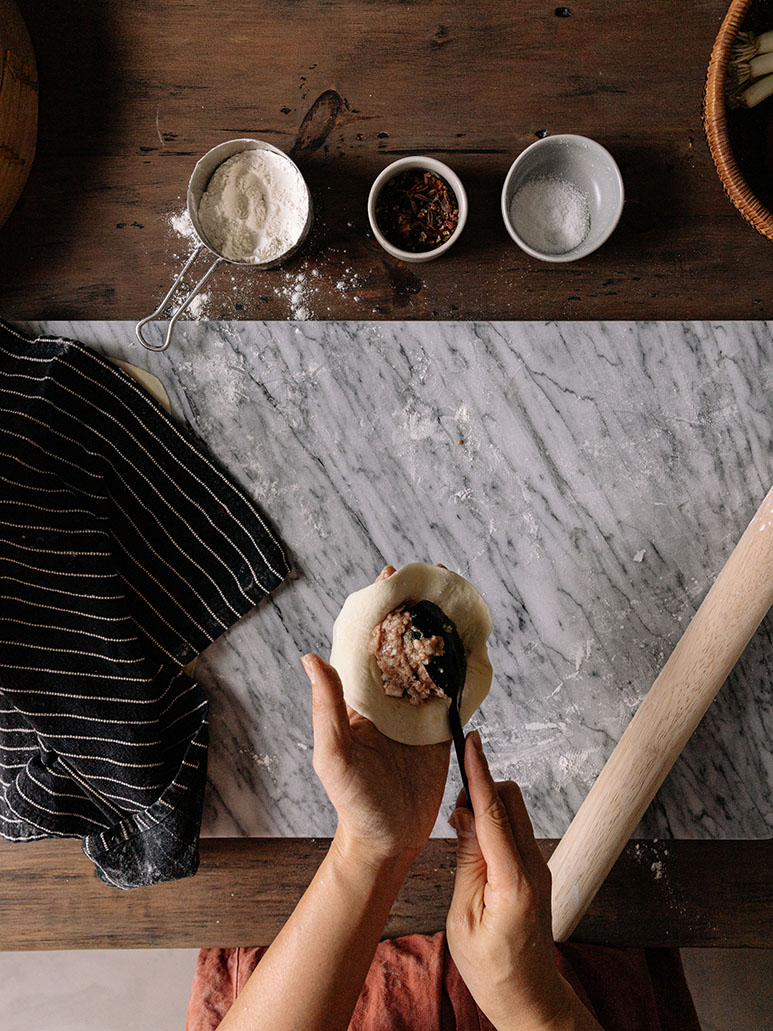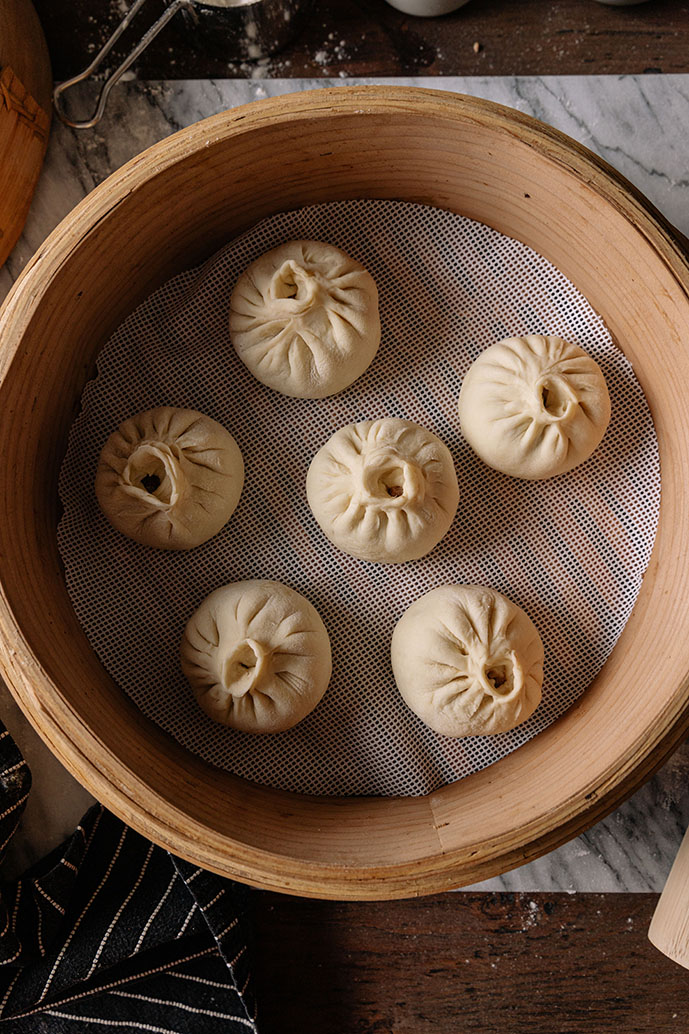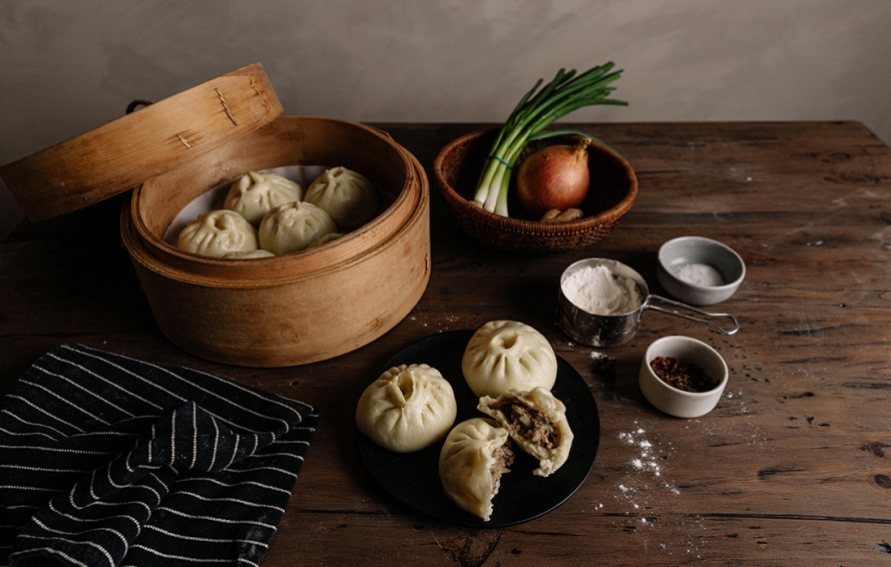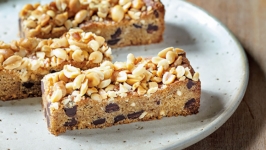Preparation
Broth
2 tablespoons ginger, peeled and sliced
2 star anise seeds (optional)
1 teaspoon Sichuan black peppercorns
3 spring onions, white bulb chopped
1/3 cup boiling water
Meat filling
1 pound lean ground beef
Onion, ginger, pepper water (recipe above)
1 tablespoon soy sauce
1 tablespoon salt
1 teaspoon Sichuan or white pepper powder
1 large onion, peeled and finely chopped
3 spring onions, greens chopped
2 tablespoons sesame oil
Dough
1 cup of lukewarm water
1 tablespoon cane sugar
2 teaspoons active dry yeast
3 cups all-purpose flour, plus extra for kneading and rolling
½ teaspoon salt
1 teaspoon baking powder
1 teaspoon vegetable oil, plus extra for coating the bowl
To make the broth, boil water in a kettle. Add the ginger, star anise, spring onion and peppercorns to a bowl. Pour 1/3 cup of boiling water into the bowl to steep and let cool.
To make the filling, add the meat to a large mixing bowl. Gradually stream in the broth, mixing until incorporated. Add the salt, soy sauce, pepper powder, onion and green onion, stirring continuously. Lastly, add in the sesame oil and mix. The oil will prevent the mixture from becoming too watery. Set the filling aside until ready to use.
If you are making the filling ahead of time, mix everything together aside from the onion and sesame oil until you are ready to pleat the buns. This will prevent the vegetables from becoming too watery.
To make the dough, add the yeast, warm water and sugar to a small bowl and stir to dissolve the yeast. Let it sit for 5 minutes to activate the yeast. The liquid should foam and look creamy. It’s important to use fresh yeast.
In a large mixing bowl, add the flour and make a well in the centre. Sprinkle the baking powder around the outer ridges of the bowl so it will incorporate later.
Slowly add the yeast mixture to the flour, mixing with a pair of chopsticks as you go. The dough should come together into a loose mound. When there are no dry patches left, add the vegetable oil and knead for 8 to 10 minutes. You’ll know that the dough is ready when you have shiny hands, a clean bowl and shiny dough. The dough should be smooth and soft like a baby's bottom. If the dough is too sticky, add flour or vegetable oil. If the dough is too dry, add water to your hands and continue kneading.
First rising
Place the kneaded dough in a well-oiled bowl. Let sit in a warm spot for 1 to 2 hours until it has doubled in size. The time will depend on the temperature in your home, so keep a keen eye on it. To check if the dough is ready, pull it away from the edge of the bowl. There should be strands of airy, honeycomb-like textures.
Using well-oiled hands, lift the dough out of the bowl onto a floured surface. Knead for another 5 minutes until the air bubbles have popped and you have a smooth round ball. The fewer air bubbles, the smoother your buns will be. Roll the dough into a log and divide it into two portions. Cover one portion of the dough with a clean dishcloth while you work with the other half. This will prevent the dough from drying out.
Divide your portion of dough it into five pieces. Each piece should weigh approximately 45 grams. Knead and roll each morsel into a round, smooth ball.
Rolling the wrapper
Flatten a morsel of dough with your palm. Using a rolling pin, roll it from the edge toward the centre, without actually rolling the centre of the dough. You want a thick centre and thin edges on your wrapper. The wrapper should be four to five inches in diametre.
Pleating the bun
Place the wrapper in one hand and scoop a heaping tablespoon of filling into the centre. The filling should weigh 30 to 40 grams. For beginners, start with a minimal amount of filling to help the pleating process. Flatten the filling with a spoon and follow the steps below.
With your right forefinger and thumb, firmly pinch an edge of the wrapper to make the first fold.
Continue pinching folds with your right index finger and thumb. Rotate the wrapper with your left hand as you go, pinching until the whole bun is pleated. While pleating, use your left thumb to press down the filling so the dough comes over the filling. Your right thumb should never leave the bun. Seal the bun with a series of pinches to form the pointy top of the bun. Repeat with the remaining dough and filling.
Second rising
Line your steamer with parchment paper. Transfer your buns to the steamer, cover them and let them sit for 20 to 30 minutes. The second rising will allow the buns to be pillowy and soft. You’ll know the buns are ready when they have expanded in size and are fluffy and light to the touch.
Steaming the buns
To steam the buns, bring a pot of water to boil. Place the steamer on top and immediately turn the heat to medium. Steam for 12 minutes and let sit for 3 minutes before taking the lid off. This will ensure your buns do not deflate with the quick temperature change.
Serve immediately, or let cool and refrigerate or freeze. To reheat, steam for 2 to 3 minutes in a steam or microwave with a wet paper towel covering on top.
To speed up the rising process, cover your dough and place in the oven with a plate of boiling water underneath. The temperature should bearound 100 F. The dough should be ready around 45 minutes.











